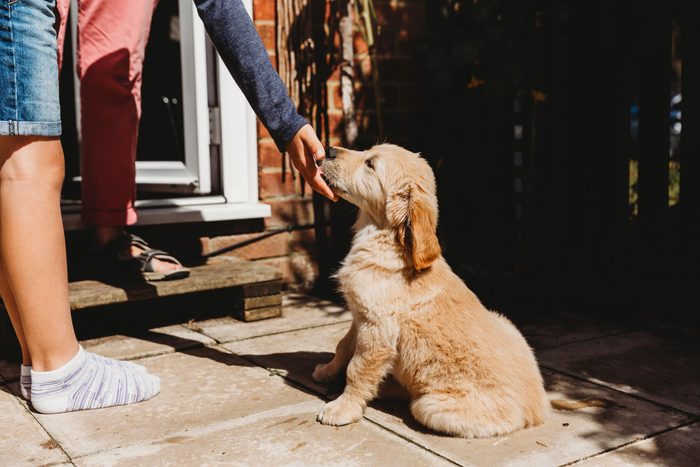
Learning how to train a puppy
Welcoming a new puppy into your home is an exciting time. The silly smiles! The floofy fur! The sweet baby snores! But cuteness aside, having a bitey, jumpy, barky, piddling pooch is a lot of work and a big responsibility. The foundations you establish in the beginning are crucial for building a strong bond, creating a confident, calm adult dog and maintaining a harmonious household. Learning how to train a puppy involves patience, consistency, routine and reward, just as it does when learning how to train a dog as an adult.
The good news is that puppies are like eager little sponges in those first few months. If you get it right from the beginning, you’ll be setting them up for future success.
And it’s not all about teaching dog tricks like rolling over or dog commands like lying down. Professional dog trainer Erin Askeland explains that the focus should first be on getting your pup comfortable with you and your family, the routine and potty training. Trying to do too much too soon can be stressful for you both. “Too often I see puppies arrive in their new home one day, and the next they are being thrown into a variety of overwhelming situations they are not yet equipped to handle,” Askeland says.
Check out these expert-approved puppy-training tips to get you both off to a strong, stress-free start.
Get Reader’s Digest’s Read Up newsletter for travel, humor, cleaning, tech and fun facts all week long.
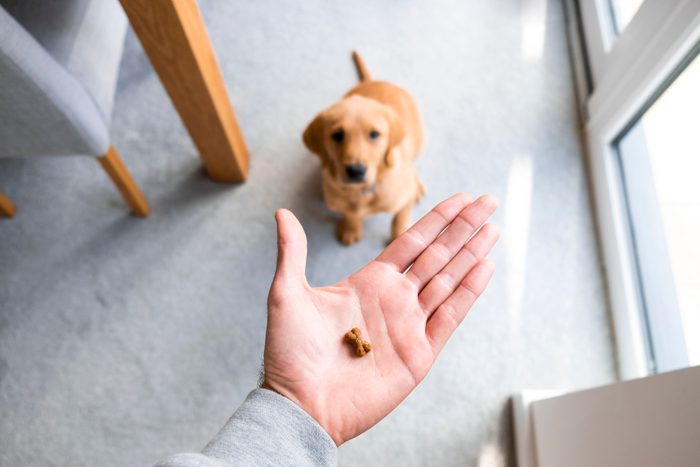
Tips for training a puppy using positive reinforcement
While it can be frustrating when your puppy pees on your rug or chews up your slippers, punishing it is a common dog-training mistake. “I don’t recommend using fear or aversive training methods, as there are many behavior fallouts that negatively impact a dog’s overall health and wellness,” says professional dog trainer Darris Cooper. He recommends using reward-based, positive training techniques. They’ll motivate and encourage your puppy to make good choices while reinforcing behaviors you want the dog to continue.
Positive reinforcement strengthens the bond of trust between you and your puppy, makes training fun and helps dogs learn to love things that used to worry them. Plus, studies show it’s quicker and more effective than punishment-based training.
“Use a variety of ‘high value’ treats and other rewards that create a positive association for your dog,” Cooper says.
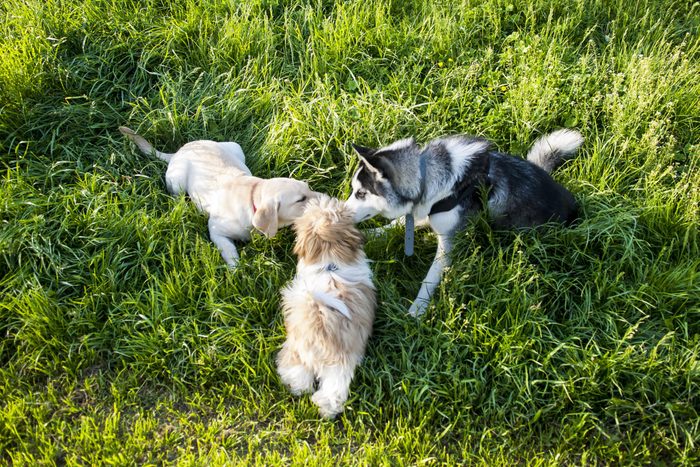
Tips for socializing your puppy appropriately
“During your dog’s first three months, sociability outweighs fear—and hence this is the prime window to show your dog positive experiences in the world,” says professional dog trainer Nicole Ellis. Askeland describes socialization as a gradual, ongoing process that helps dogs learn how to cope in healthy ways when introduced to new or unpredictable situations. These include car rides, fireworks displays, people-watching and controlled introductions with other dogs.
Professional dog trainer Kait Hembree says it’s about taking things slowly and advocating for your pup—so no hectic puppy parties, dog parks or big family gatherings. “Leave home prepared with treats to be given during the exposure to make it positive,” she says. “Start small by going to less-busy environments and work up to bigger events.” Leave or reset the situation to be less intense if your puppy shows signs of worry.
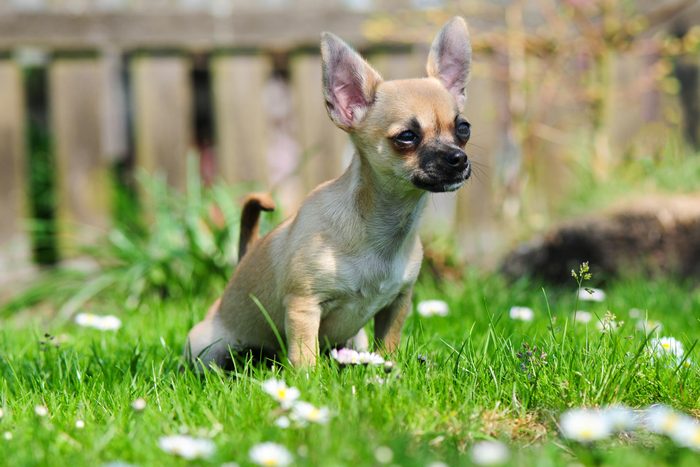
Tips for training your puppy to go potty outside
Potty training a puppy won’t happen overnight. But by prioritizing this task with patience, perseverance and on-the-ball supervision, you won’t need to rush to stop your dog from peeing in the house for too long.
“A puppy needs a consistent routine of getting outside to potty at appropriate times—often after meals, naps or play,” Askeland says. And always offer your puppy a tasty treat immediately after they potty outdoors so they associate doing it there with good things. Scolding your pup damages your bond, and they may resort to pooping or peeing behind your sofa or somewhere else out of view.
Pro tip: While you’re potty training, invest in a reusable puppy pad and prepare to clean dog pee from your carpets. “Be sure to clean those accidents up properly with an enzyme cleaner made to get rid of the urine smell,” Ellis says.
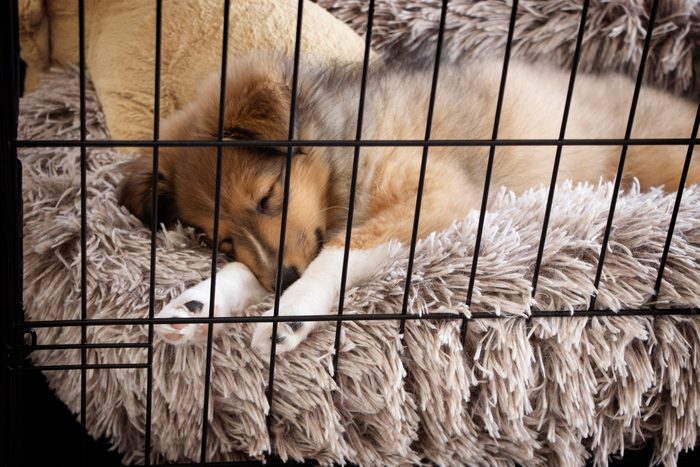
Tips for crate-training your puppy
Dog crates can be invaluable management tools when learning how to train a puppy. Askeland explains they can help your pet develop bladder control, prevent destructive behaviors and create boundaries. “It’s also good to get a puppy comfortable in a crate, as they may need to be in one for things like healing from injury, at a vet hospital, boarding or travel,” she says.
Provided you make the proper introductions, a crate is “just like a favorite chair or under the bed or anywhere else that the dog feels safe enough to close their eyes and dream,” Ellis says. It’s all about positive associations, not leaving your pup in the crate for too long, building up time gradually and never using it as a punishment.
Pair crate time with food-stuffed toys or dog lick mats. And, as Askeland points out, only use the crate after meeting the basic needs of potty time, food, water and exercise.
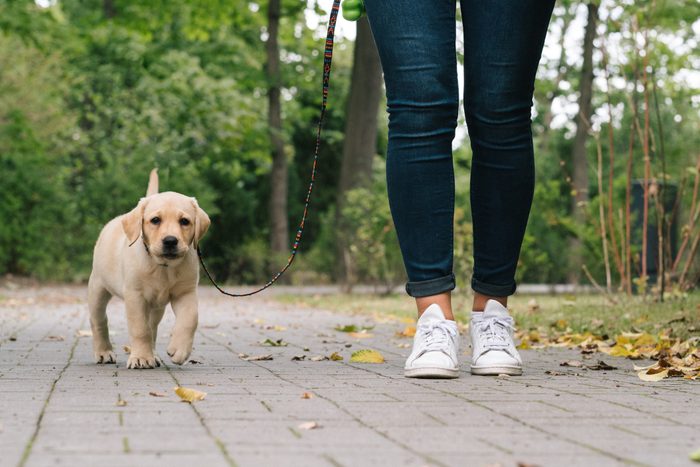
Tips for training your puppy to walk on a leash
A puppy chewing, grabbing and pulling at its leash on a walk isn’t a recipe for success; neither is a pup that’s too scared to move. When working out how to train a puppy to walk on a leash, the goal isn’t to have your dog heel perfectly right out of the gate but to build positive associations and calm behaviors. Start slowly in the house, pairing every step with yummy dog treats.
If your confident puppy constantly grabs the leash, stop and wait for it to offer a more appropriate behavior before rewarding it. For panicky puppies, take things slowly and don’t force it. “Toys, play and interactions like petting and verbal praise can all be used when thinking about rewards,” Cooper explains.
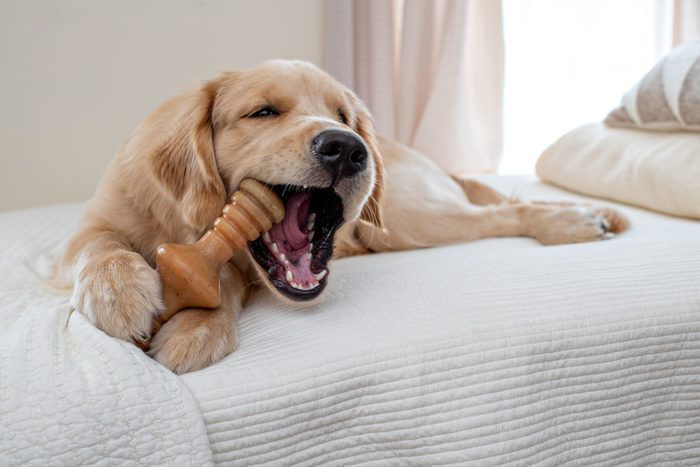
Tips for training your puppy to be left alone
It can be tempting to be with your puppy 24/7 once you bring it home. But rather than letting your dog follow you everywhere, getting it to feel comfortable being left alone helps prevent separation anxiety.
Hembree’s biggest tip is to start the process immediately. “This could be as simple as giving them a food toy or chewy and walking out of the room,” she says. “Then you slowly build on the time you are out of the room, and this can be practiced both with a crate and outside of their crate, if you are using one.”
The goal is to gradually advance from leaving your puppy for a few seconds to a few minutes. Once it’s potty trained, your dog should be able to stay relaxed while left alone for up to a few hours.
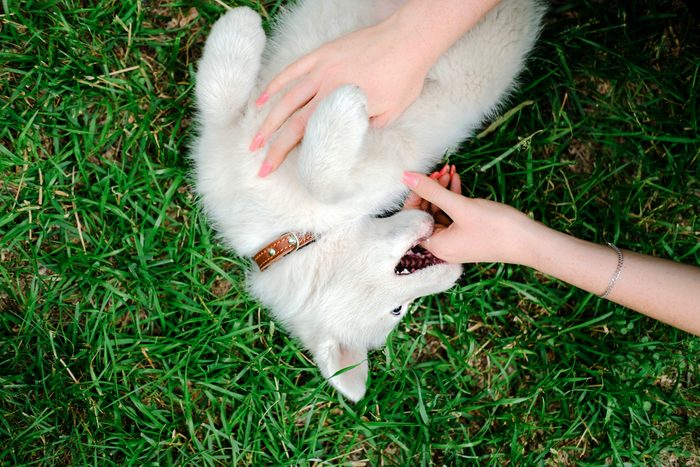
Tips for training your puppy not to nip
Puppies explore with their mouths, and nipping is normal dog behavior. “It starts as play. It’s what puppies do with each other. It’s what puppies do with almost everything they encounter,” says Ellis. But those needle-like teeth can be nasty, especially if you have young kids.
Teaching bite inhibition—using the teeth gently—is an integral part of how to train a puppy to stop biting. When the teeth come out, stop playing, say “Ow” and try redirecting the dog to a chew toy. Immediately leave the room if your pup is still determined to bite at your arms or grab your trouser legs. Dogs are smarter than we think, and your puppy will quickly learn that using teeth results in the fun stopping.
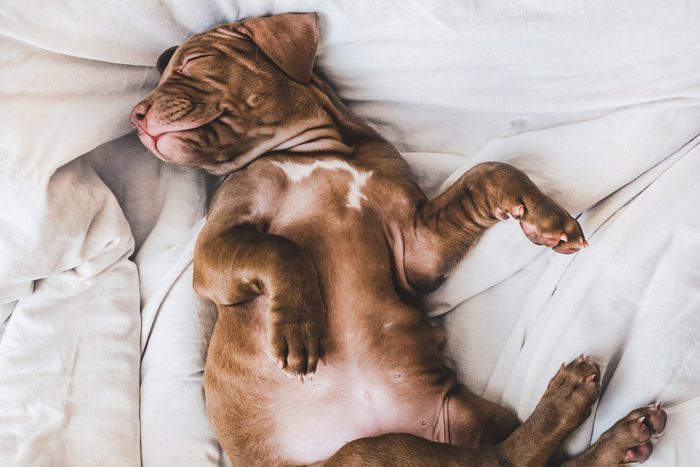
Tips for training your puppy to settle overnight
A whole first night of howling is stressful for everyone, and handling it poorly could inadvertently reinforce the behavior.
Askeland points out that dogs generally howl, whine or bark because of some type of need. “To handle this, create a comfortable environment, establish a consistent routine and gradually introduce alone time during the day to reduce the anxiety of being alone at night,” she says.
She recommends ensuring your pup has enough exercise, play and mental stimulation—and a final potty time before bed. Incorporating calming scents and sounds could also encourage sleep.
If you don’t want your puppy in your bedroom permanently, letting your dog sleep on your bed could be a hard habit to break. Instead, if your dog is anxious on the first night, try storing the crate near your bed and, over time, moving it farther away.
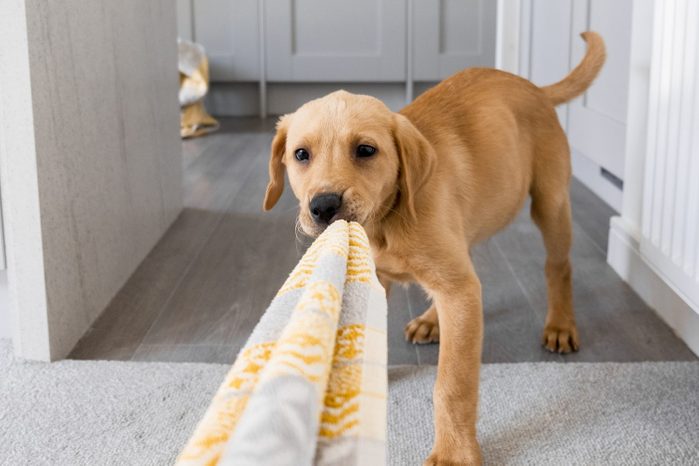
Tips for training your puppy not to chew furniture
Your table legs, slippers and kid’s toys don’t need to be victims of your teething, mouthy puppy. “Dogs get bored, so having a variety of appropriate chewable items that can be rotated helps keep them from finding something new to explore with their mouth,” Hembree says. Experiment to see what your puppy likes and how tough it is on its toys. You might need to opt for near-indestructible dog toys for the power chewers.
An important note: You’re not setting your dog up for success by leaving items around the house. Puppy-proofing your home and always supervising reduces the risk of damage to both your decor and dog.
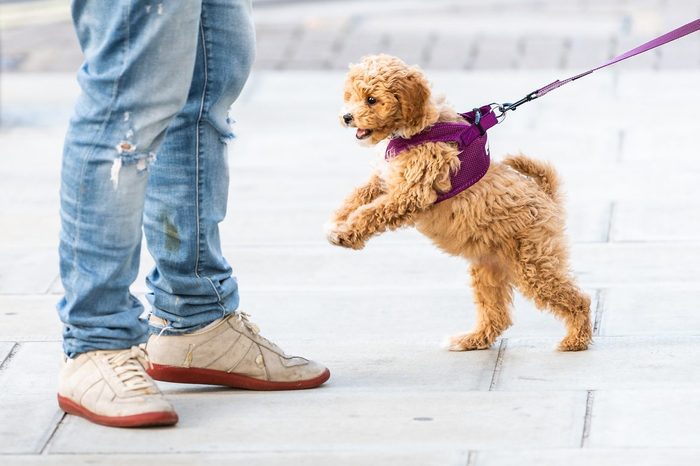
Tips for training your puppy not to jump up
Studies suggest that jumping up is one of the most common and least-desirable behaviors in dogs. When friends and family come around, you want to encourage calm greetings.
Cooper says it’s all about “rewarding the behaviors you want to see continue and teaching alternative behaviors to those you want to curb.” When it comes to how to train a puppy not to jump up on arriving guests, he suggests teaching your dog to go to its bed on cue. Lots of rewards for this alternative behavior and for calm greetings with all four paws on the floor are key. And it’s OK to use tools like a leash to help manage the situation.
If you’re diligent and patient, you can break your puppy’s jumping habit, no matter whether you have one of the easiest dogs to train or the hardest.
Get Reader’s Digest’s Read Up newsletter for more pet tips, humor, cleaning, travel, tech and fun facts all week long.
About the experts
- Erin Askeland is an animal health and behavior expert and certified professional dog trainer at Camp Bow Wow. She is an animal welfare professional with a master’s degree in clinical animal behavior and is also a certified behavior consultant for canines and a fear-free-certified professional.
- Darris Cooper is the national dog-training manager at Petco. He is a certified professional dog trainer and holds certifications as a fear-free animal trainer, American Kennel Club Canine Good Citizen evaluator and member of the Association of Professional Dog Trainers. Cooper is the head of diversity, equity and inclusion for the International Association of Animal Behavior Consultants.
- Nicole Ellis is a certified professional dog trainer, American Kennel Club Canine Good Citizen evaluator, member of the Association of Professional Dog Trainers and part of Rover’s Pet People Panel.
- Kait Hembree is the head of training at GoodPup. She has extensive experience working with behavior modification in veterinary practices and animal shelters and regularly consults as a dog behavior expert across the country.
Sources:
- Animals: “Characteristics of Excitable Dog Behavior Based on Owners’ Report from a Self-Selected Study”
- BioRxiv: “Does Training Method Matter?: Evidence for the Negative Impact of Aversive-Based Methods on Companion Dog Welfare”
- Applied Animal Behaviour Science: “Survey of the Use and Outcome of Confrontational and Non-Confrontational Training Methods in Client-Owned Dogs Showing Undesired Behaviors”
- Journal of Veterinary Behavior: “The Relationship between Training Methods and the Occurrence of Behavior Problems, as Reported by Owners, in a Population of Domestic Dogs”
